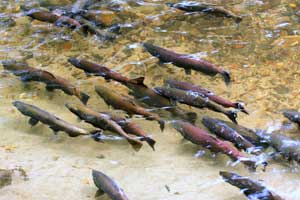Chinook (or King Salmon) Reproduction

Successful salmon spawning depends on several factors.
- Their habitat must be able to support the foods required for young Chinook, (King) Salmon as well as adults.
- The water in which the spawn must be clean, cool and well oxygenated and have very low turbidity.
- Both their ocean habitats and freshwater habitat must be clean and healthy.
- Their numbers need to be sufficient enough to be able to sustain their population in their birth stream.
Chinook Salmon Headwaters
5. For Chinook Salmon spawning in the headwaters of their birth stream the river bed must be gravel based and relatively solid to prevent the gravel from shifting and crushing the eggs. The water is no deeper than 36 inches and may be as shallow as 12 inches. However the average depth for spawning is between 20 to 36 inches.
Chinook Salmon Lifecycle
Chinook salmon spend 3 to 4 years in the ocean before returning to their home rivers to spawn.
Spawning Season and Process
Spawning begins as early as September and continues through to December, depending on which part of the distribution they are found.
Unlike other fish species, the female is responsible for creating the nest and guarding it for anywhere from 4 to 25 days. Most females don’t make it back to spawn again. The male Chinook Salmon will spawn with other females and don’t play a part in guarding the nest or protecting the young alevin.
The eggs usually hatch in early spring once the ice has left the rivers. This can take anywhere from 3 to 5 months.
Fry and parr will stay in their birth river for 12 to 18 months before traveling downstream to estuaries, which is when they become smelt. Smolts undergo a physical change that allow them to be able to live in salt water.
Chinook Salmon Don’t Die After Spawning
Now it might seem to the expert angler that I’m off my rocker here and don’t know a thing about Chinook Salmon. Even the armchair angler or casual reader might say, ‘hang on, I’ve seen rivers of these fish dead after spawning’.
Stating that Chinook Salmon don’t die after spawning is just as incorrect as stating that Chinook Salmon die after mating.
While the majority of Chinook Salmon do die after spawning, a significant number manage to return to the ocean to spawn again. It’s estimated that somewhere over 90 percent perish. In some parts of their distribution as little as 2 to 4% survive.



